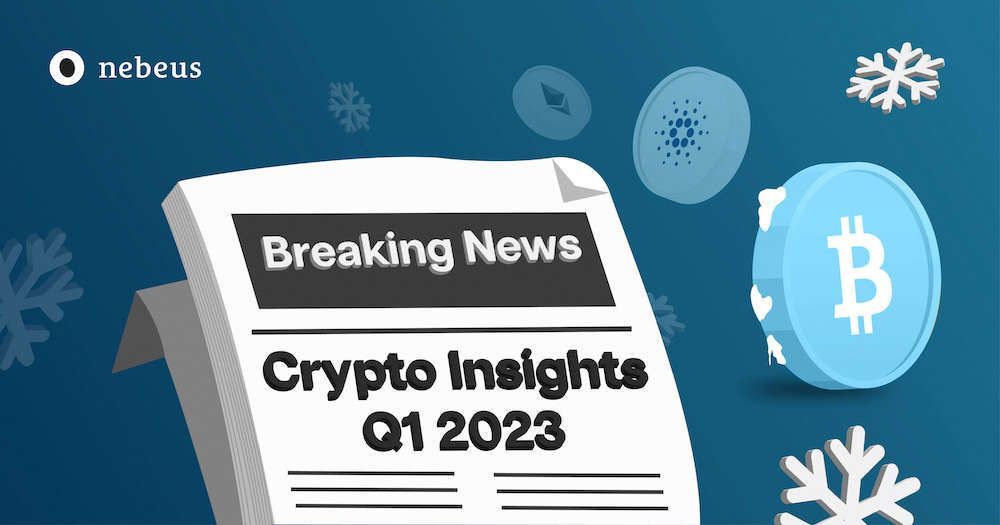Market Overview
2022 was not a kind year to crypto investors when compared to the previous year - events such as the FTX debacle, Bitcoin dropping to nearly a quarter of its highest value, Celsius going bankrupt, and the biggest bear market in crypto history nearly destroyed all confidence in the future of crypto.
However, as we have always said in our previous quarterly reviews: the storm will pass.
We owe the future of Crypto to those who have remained calm and had faith that the bad times don't always last.
So will 2023 be the year that things begin to turn around?
In this quarterly review, we’ll look at 2023 so far and how we already see some positive signs, such as Bitcoins rebound, the ramifications of the FTX collapse, DeFI LTV being up $10 billion, NFTs & the Metaverse.
Bitcoin is already up 50% in 2023 (compared to 2022)
As expected, Bitcoin has already begun its resurgence with a 50% increase in 2023 - the most significant growth since October 2021.
On January 29th, Bitcoin hit $23,920, from a previous low last November of $15,253, and dropped to $23,000 on February 1st after the US federal open marketing committee meeting, where the committee announced that 25 basis points would raise interest rates.
However, Bitcoin predicted the outcome of the meeting and factored that into its pricing.
The change was connected to the FTX collapse in November last year, which saw a massive increase in Bitcoin trading across all trading platforms, reaching 200,000 BTC/month due to both people wanting to sell quickly and others looking to cash in on Bitcoin going at a low bearish rate.
The bullish phase is slowing down, with net flows returning to a more neutral level.
The increase shows positive signs for Bitcoin's future in 2023, with many believing that the value will increase further over the course of the year, with some predicting that Bitcoin could reach $45,000 by June/ July.
FTX collapse consequences are over?
2022 took crypto into the mainstream but only sometimes for the right reasons. For example, the FTX collapse dominated the news cycle at the end of last year, with people becoming engrossed in the intrigue and drama attached to the debacle.
But have we seen the end of it?
The collapse sent shockwaves throughout the crypto world and shattered investor trust. Before the destruction, Bitcoin was set to make a significant return, only to suffer one of the most considerable losses in its history, losing nearly 64% of its value, triggering an incredibly aggressive bear market.
Whether crypto traders will ever have the same level of trust as before the collapse remains to be answered. However, steps are underway to ensure that nothing of this magnitude ever happens again.
Whatever your position, it remains that the apparent holes in crypto security have been laid bare for everyone to see. Therefore, from here on, crypto trading platforms now have to vastly improve their safety and management if they want to bring back trust.
Those who believe that crypto will rebound see the silver lining to all this and no doubt believe that crypto will become safer than it’s ever been so long as the proper measures are implemented.

Crypto markets are going up
If we take a step back from the details of the crypto world over the past several months, we can see that crypto markets are going up overall.
Crypto giants, Ethereum, have had a resurgence since the end of last year, making an almost 50% increase in value, with analysts predicting even more growth throughout the rest of 2023.
However, it is not just crypto giants Bitcoin and Ethereum enjoying the spoils of this new boom; several smaller altcoins have also seen impressive growth.
ADA has seen 20% growth this year, alongside small coins such as AVAX, FTM and APT, which have seen growth as significant as 82%, 143% and 382%.
We can’t say how long this initial growth will last, but it shows that even something as catastrophic as the FTX collapse cannot cripple crypto.
DeFi TVL up $10 billion despite persistent fears and hacks
Trickling down from Bitcoin's success in Q3, other coins, such as Gala and Apto, saw 100% growth. This comes amid fears and anxieties regarding short positions at the end of last year. However, Solana protocol, Frikton have halted deposits amid fears of a future recession.
Anxieties aren’t just about a recession; last year saw some huge hacks that deeply unsettled the crypto world regarding the security of crypto trading.
In particular, Mango markets is suing hacker Avraham Eisenberg for $47 million dollars plus interest for his audacious attack on DeFi protocols.
This comes as no surprise, given that Eisenberg stole over $117 million in funds by manipulating the price of the Mango token and made no secret of doing so. Eisenberg claimed that his strategy was “legal” and “highly profitable”.
Whether readers agree with Mango or Eisenberg, the lawsuit shows that big crypto firms will no longer accept reckless trading or market manipulation. However, the suit is ongoing, and we will have updates in the coming weeks and months.
Crypto market cap analysis
2021 saw the all-time highest market cap for crypto, reaching $3,009 billion, dropping to $727.58 billion the following year.
The drop was largely due to the events discussed above that caused an avalanche of uncertainty and mistrust toward crypto in general. However, with these events now behind us, we can begin to look toward a brighter future and a return to previous market caps - or higher.
The market cap currently sits at a similar level to what it did at the beginning of 2021, with further growth predicted over the next 12 months.
Crypto Winners & Losers Summary
Crypto Winners
Since Bitcoin is still recovering (albeit positively) from the previous year, calling them crypto winners might not be suitable. So instead, that mantle must go to some of the smaller altcoins that heroically weathered the storm of 2022.
As previously mentioned, in Q1, APT has already seen 382% growth, with even further growth throughout the year.
However, there are a few other notable mentions that readers should be aware of:
GMX: Performed well during the FTX collapse and has seen an impressive YTD return of nearly 111%
TWT: Similar to GMX, TWT performed well in the closing months of last year and saw a YTD return of 92%
Crypto Losers
Given the amount of damage inflicted on the crypto markets in 2022, there are plenty of options to choose from when discussing crypto losers. But one of the biggest has to be Solana which lost nearly 95% of its market value over the past 12 months.
Starting at a value of $172 at the beginning of last year, Solana has taken several hits due to the Terra crash and the FTX collapse. Forecasters predict that Solana will see further losses despite its scalability.
Another promising coin that didn't live up to expectations was Algorand.
Despite being incredibly popular in the early to mid-stages of last year, Algorand has dropped 83% since January this year. However, given its ability to process a million transactions per day using the proof-of-stake method, the future of Algorand is still being determined.
Algorand could rebound, given the right circumstances.
NFTs & Metaverse
Despite the bearish market of the past 12 months, NFTs & the Metaverse have been making steady gains despite what most believed would be the case.
If you want to know more about NFTs & Metaverse, see our blog post on NFTs and our analysis of the Metaverse.
While many thought that NFTs & Metaverse would come and go, we are seeing more and more big companies invest in the process, i.e. Nike and their acquisition of NFT producer CloneX.
However, it is still early days, so it’s impossible to say what will happen. However, here are a few things to watch out for in 2023.
Blockchain-based games:
NFTs and their use in gaming are becoming more apparent as users can now use NFTs to own and purchase digital assets within gaming. This trend is expected to grow as Metaverse plans to implement more blockchain-based games.
Art galleries:
As up-and-coming artists struggle to find ways to exhibit their art, NFTs and Metaverse, provide a lucrative way to exhibit their talents without entering physical galleries.
By sharing and selling their art using NFTs in the Metaverse, artists can reach new audiences and display their art in ways not previously possible. Also, artists can present their art in new ways using soundtracks, 3D modelling and text to give viewers more unique experiences.
Crypto regulation worldwide: Q1 2023
Crypto regulation updates in Europe
Ukraine: despite the conflict, ANC pharmacies in Ukraine are now accepting payments using Binance pay to make it easier for those needing the medical supplies they need without having to exchange their fiat currencies.
Italy: Italy has recently passed a new crypto tax law, meaning any capital gains made over €2000 will incur a 26% tax. In addition, for those unable to calculate their tax due to fluctuating prices, there will be a flat 14% tax rate.
France: not willing to wait for the European union's crypto court to set licensing laws, the bank of France’s governor, François Villeroy de Galhau, wants to enact tighter licensing laws on crypto companies to ensure that any crypto company wishing to trade is registered with France’s AMF.
Crypto regulation updates in North America
US federal reserve warns banks about the insecurity of cryptocurrencies and urges them to be cautious given the events of the past 12 months.
Canada looks to enact more regulations on stablecoins to ensure they do not cause instabilities in the overall financial system. In addition, Canada is concerned that the top three stablecoins control 90% of the market, and 1% of investors own 90% of the whole market.
Crypto regulation updates in Asia
The head of India’s reserve bank, Shaktikanta Das, warns that crypto could cause the subsequent global financial crisis due to the lack of regulation and the potential for easy market manipulation and hacking.
Das believes crypto trading is similar to gambling and believes it goes against the RBI and undermines the whole economy. However, crypto traders in India disagree and want a more crypto-friendly head of the nations leading bank.
Israel's security authority (ISA) is looking to implement stricter crypto trading laws to ensure that digital assets are treated like fiat financial investments. The ISA believe that crypto trading presents security threats and needs to be monitored appropriately.
Crypto regulation updates in Latin America
El Salvador continues its crypto push by issuing a law regulating the issuance of other digital assets besides Bitcoin.
It might not surprise those watching El Salvador, given that they were the first country to implement Bitcoin as a legal tender.
El Salvador has always struggled financially owing to civil disputes and gang crime. Still, their crypto investment is a bid to bring in investors to help bolster the country's financial system.
Likewise, Brazil has begun introducing Bitcoin and other cryptocurrencies as legal tender allowing citizens to use digital assets to pay for daily items. The framework is still in its infancy but is set to change how South America's largest nation uses crypto.
Conclusion
All those reading know that Crypto has been taking hits since the beginning of last year. Still, with recent data, we can see that things are now “on the up,” with investor trust returning alongside added security measures and more creative ways to implement crypto into daily life.
What will happen over the next three months? We can’t say for sure, but if the forecasts are correct, we are in for a good year as crypto traders and enthusiasts.
You can sign up for a Nebeus Account and bridge your crypto and cash.
La inversión en criptoactivos no está regulada, puede no ser adecuada para inversores minoristas y se puede perder la totalidad del monto invertido.










